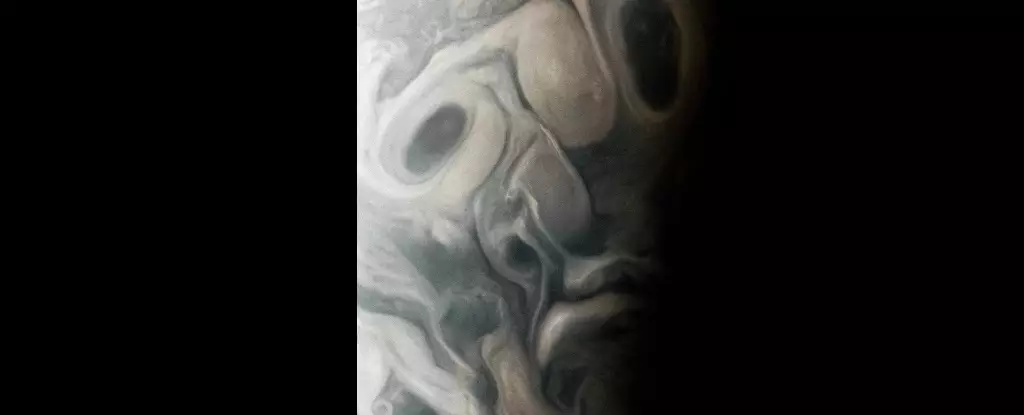Jupiter, the colossal giant of our solar system, may not be an inviting place for humans, but its magnificent and tempestuous nature never fails to astonish us. Beyond its enormous size and the storms that could engulf our entire planet, the swirling cloud formations on Jupiter often take on eerie and unnerving shapes. Recently, NASA’s Juno probe captured an image that bears a striking resemblance to a face filled with angst and dread, reminiscent of the famous painting “The Scream” by Edvard Munch. This photograph was taken during Juno’s 54th close flyby, or perijove, on September 7, 2023, and it showcases a region in Jupiter’s far north known as Jet N7.
Jets on Jupiter play a crucial role in shaping the planet’s distinct features. These wind streams separate Jupiter’s pale belts and brown-red zones, penetrating deep into its atmosphere and generating intricate and captivating cloud patterns. Juno’s perijove provided a unique opportunity to observe the terminator over Jet N7, which is the thin line that separates day and night on the planet. This phenomenon is essential for scientific study as oblique sunlight lengthens shadows, revealing more details and textures in Jupiter’s cloud tops. By closely examining these features, scientists can gain insights into the enigmatic dynamics of Jupiter’s violent storms.
Juno has been instrumental in unraveling the mysteries of Jupiter since its first perijove in July 2016. With each close approach, which occurs approximately every month or two, Juno captures breathtaking images of the planet’s awe-inspiring clouds. Through the lens of this remarkable spacecraft, scientists have gained unprecedented access to Jupiter’s atmospheric dynamics and have made significant strides in understanding its complex workings. Despite being far from Earth, Jupiter continues to captivate our imaginations and drive us to explore further.
As humans, we possess a unique cognitive ability called pareidolia, which drives us to recognize patterns and familiar shapes in random or abstract stimuli. Whether it is spotting animals in cloud formations or perceiving faces in everyday objects, our minds naturally seek and assign meaning to these visual patterns. The phenomenon of face pareidolia, in particular, is incredibly potent. We are capable of perceiving emotions, age, and even gender in illusory faces, sometimes ascribing a profound sense of human experience to these ethereal images.
Considering the prolific nature of pareidolia, it is somewhat surprising that we do not stumble upon face-like formations more frequently in Jupiter’s clouds. With its colossal size and ever-changing weather patterns, Jupiter seems like a prime candidate for such phenomena. Perhaps, though, we simply need to allocate more time and dedication to scrutinizing the intricate details of this gas giant. By observing closely and with an open mind, who knows what other captivating images and hidden secrets of Jupiter we may discover?
Jupiter, with all its grandeur, remains a mesmerizing enigma. Our current knowledge of this colossal planet is limited, and many mysteries continue to baffle scientists. Nevertheless, through our technological advancements and tools like Juno, we are making remarkable progress in peering through the veil of Jupiter’s secrets. By analyzing its magnificent cloud formations, unraveling its atmospheric dynamics, and studying its awe-inspiring storms, we inch closer to understanding the behemoth that dominates our celestial neighborhood.
Intriguingly, the haunting face-like formation captured by Juno serves as a reminder of the immense beauty and power that emanates from the depths of Jupiter. Its turbulent clouds, swirling with hues of mystery, provide a glimpse into a world unlike anything we have witnessed before. Through the lens of exploration and scientific discovery, we continue to delve into the wonders of our universe, uncovering celestial marvels that push the boundaries of our imagination. And while Jupiter may be an uninhabitable gas giant, it never fails to fill us with awe and wonder.
In a world teeming with celestial wonders and infinite possibilities, our quest to decipher the enigmatic nature of Jupiter and explore the secrets of the universe remains an unending endeavor.


Leave a Reply